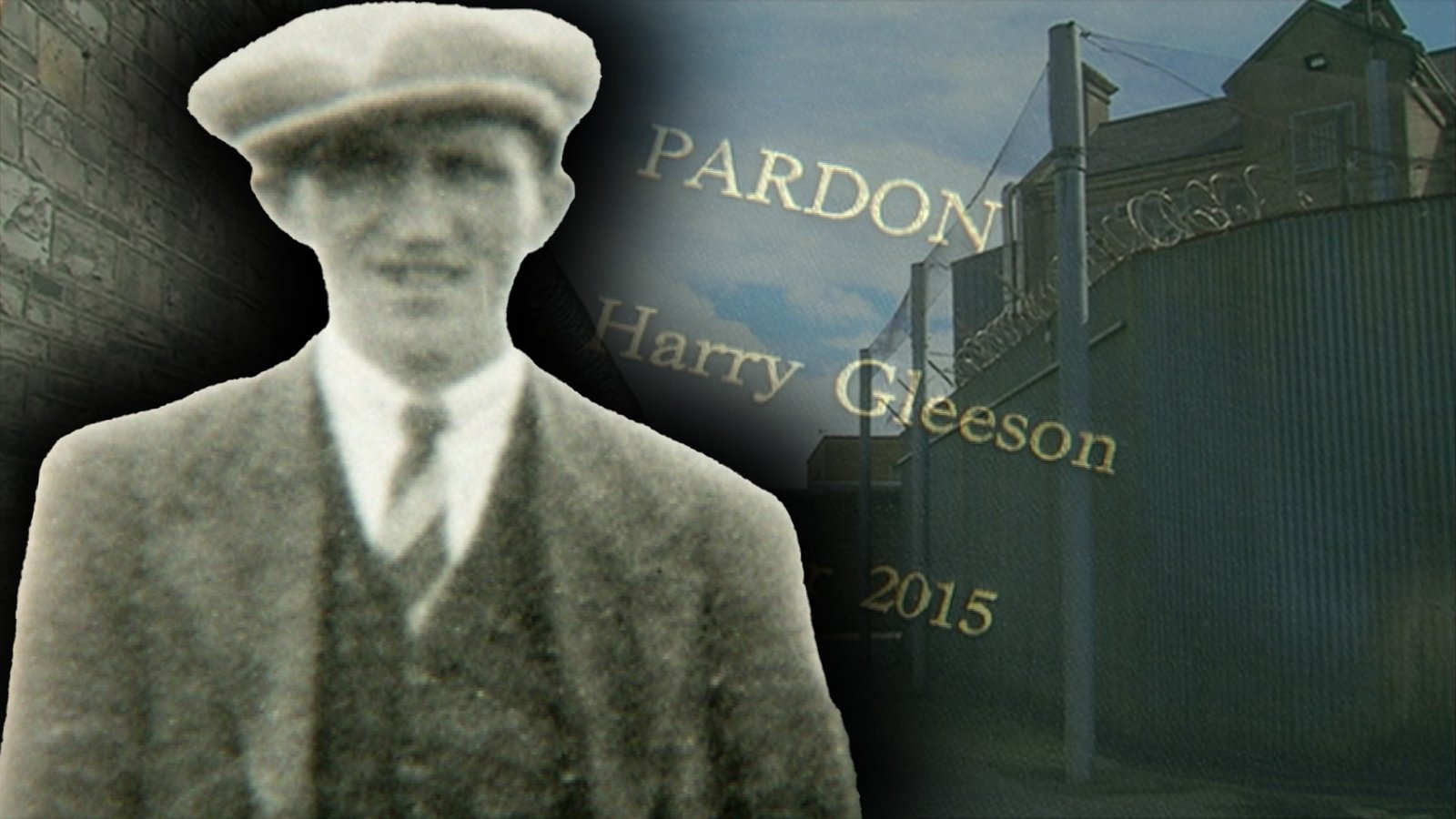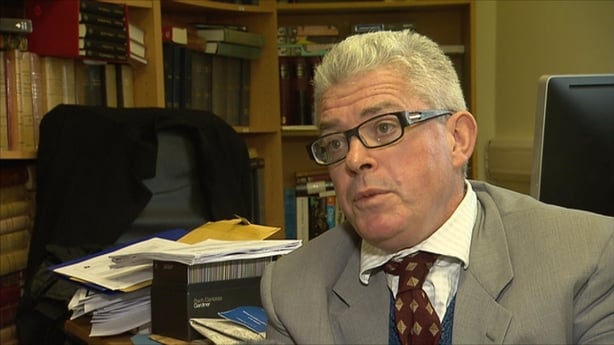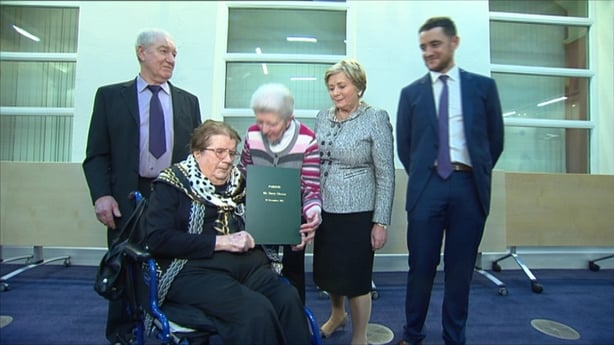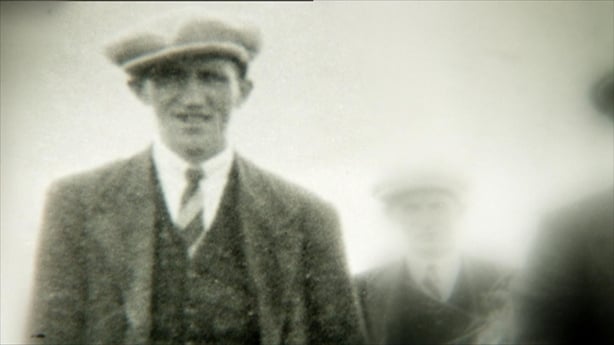World
Leaving Mountjoy, 83 years on: Gleeson’s remains are brought home

83 years after he was put to death by the Irish State for a murder which same State now accepts he did not commit – Harry Gleeson will today finally be laid to rest in his native Co Tipperary.
Prime Time Security Correspondent Barry Cummins reflects on the enormity of a man so wronged for so long, by his own country, a country now making amends as best it can.
It was a Monday last January when excavation work finally began at Mountjoy Jail. The work was slow and methodical, knowing that somewhere beneath the ground lay bodies. The work was underway to find the body of Harry Gleeson, a man who should never have been there in the first place.
The section of land to be searched was slightly more than 1,000 square metres. It was known that the bodies of executed prisoners lay buried somewhere on the eastern side of the prison, back towards the canal.
But nobody knew exactly where.
While the British had kept good records of people it had executed at the prison in previous times – noting precise burial locations – the Irish State was not so good at record-keeping after independence was achieved, and it was a body of a man hanged by the Irish State which now needed to be found.
There were no headstones, no markings of where to search.
The terrain was flat but complicated – in the decades after Harry Gleeson was buried close to the room in which he had been executed – tonnes of tarmac had been laid between the prison building and the high outer walls. The tarmac covered wherever the bodies of Harry and several other executed prisoners lay.
The plan to search for Harry Gleeson had been a long time in the making.
It was back in 2015 that Henry ‘Harry’ Gleeson was finally given a presidential pardon, with the Irish State acknowledging that he had been wrongfully convicted of murder. Quite simply, Harry Gleeson did not murder Moll McCarthy, a single mother of seven who was shot dead in Co. Tipperary in November 1940.
Someone else, never brought to justice, had shot Moll twice, once in the neck and once in the face, but it wasn’t Harry Gleeson. It was Harry who had found Moll’s body on farmland and raised the alarm.
In circumstances still mired in controversy, rather than being thanked for alerting authorities to the discovery of Moll’s body, Harry Gleeson soon found himself charged with her murder.
Justice, or more correctly in this circumstance ‘injustice’ moved swiftly in the Ireland of the 1940s.
It is almost inconceivable now to consider that within six months of Moll’s body being discovered, Harry Gleeson was dead – hanged by the Irish State.
Within those six months, Harry had been put on trial, found guilty by a jury, had pleas for clemency fail, and ultimately been executed.
It was a Wednesday morning in April 1941 that Harry Gleeson had walked to his death in a room inside Mountjoy Jail, where an executioner pushed forward a lever, releasing a trap door beneath Harry’s feet.
The manner of death had been proscribed by the sentencing Judge – ‘hanged by the neck until he be dead.’
The pardon granted posthumously to Harry Gleeson, 74 years after his killing came following decades of campaigning by his family.
They had formed the ‘Justice for Harry Gleeson’ group and in the early 2010s, and met with David Langwallner and Tertius Van Eeden of the Irish Innocence Project at Dublin’s Griffith College.

They studied the original trial transcripts and noted that back in 1941 the judge had asked for a gun register to be shown during the trial.
In fact, the register had never been produced by the prosecution, and now the ‘Justice for Harry Gleeson’ group had found the register.
This was just one of many new issues identified all these years later, which when added together, said campaigners, showed Harry Gleeson had not received a fair trial.
One of the most important issues was a fresh analysis of the temperature of Moll McCarthy’s body when it had been found.
Applying modern medical expertise to the post-mortem report from 1940 indicated that Moll had been murdered at a time when Harry Gleeson actually had an alibi.
In 2014, RTÉ’s Prime Time also featured an interview with a retired nurse who had tended to Moll McCarthy’s eldest daughter as she was nearing death.
Mary McCarthy was 19 years old when her mother was murdered. She later endured a difficult life in a Magdalene laundry.
Five decades after her mother’s murder, Mary McCarthy was approaching death and one night became very upset. Ann Martin Walsh was the nurse who tended to her at a hospital in Donnybrook in Dublin.
Ms. Walsh told Prime Time “I was on duty in the middle of the night. Mary got very upset and she came out with the words ‘I saw my own mother shot on the kitchen floor and an innocent man died’. Those were her exact words. I think she was sending a message back to Tipperary.”
In 2015 barrister Shane Murphy, who had been appointed by previous Minister for Justice, Alan Shatter, to examine the case, recommended to then Minister for Justice Frances Fitzgerald that there were indeed serious deficiencies in the conviction of Harry Gleeson so as to render it unsafe.
Mr Murphy concluded there were inconsistencies in the prosecution case, including a failure to call certain witnesses; the withholding of a Garda statement relating to the case; and the failure to introduce a shotgun register into evidence.
The issue of the time of Moll McCarthy’s death was also now very important.
Quite simply, over 70 years after the conviction and execution of Harry Gleeson, the Irish State accepted unequivocally that – based on new information and a review of the entire case file – there had been grave deficiencies in the case, amounting to a miscarriage of justice.
The Gleeson family attended a special ceremony in 2015 at the Department of Justice where a certificate of official pardon was handed over.

It was a moving moment for all the Gleeson family. They graciously accepted the pardon, but of course the sentence couldn’t be undone. An innocent man’s life had been taken. Nothing could bring Harry back.
He was 38 years old when he was put to death: a single man from a large family. He loved hurling and dogs and was well-liked by those who knew him in his native Tipperary.
A beloved son of Thomas and Catherine, and a much-loved brother of Ellen, Bridget, Hannah, Mary, Catherine, Margaret, Thomas, Timothy, John, Patrick and Cornelius.
Yet, one part of the sentence imposed in 1941 could be undone.
The full sentence imposed in the Irish Free State and later the Republic of Ireland – up to the last execution which took place in 1954 – was that, not only would a person be hanged at Mountjoy Jail, but that their body would then be quickly buried within the grounds of the prison.
Harry Gleeson should never have been executed, and it followed that his body should never have been buried in Mountjoy and certainly shouldn’t remain there now.
The Gleeson family began engaging extensively with the Department of Justice, which pledged to do all it could to find Harry’s body and return it to the family.
It took from 2015 until last Friday lunchtime before that ‘prison burial’ part of the sentence imposed in 1941 could be undone.
Shortly after one o’clock, Harry Gleeson’s family brought him out of Mountjoy. Prison officers stood silently at the front gate in a respectful acknowledgement of the historical moment.
Harry’s remains were in a fresh coffin within a hearse which had travelled that morning from Co Tipperary. His surviving relatives, different generations descended from Harry’s brothers and sisters walked in front of, beside and behind the coffin as they left Mountjoy Jail.

The hearse slowly turned left onto North Circular Road, and quietly entered Dublin traffic, en route to Tipperary. It had taken less than six months form the breaking of ground at Mountjoy Jail on 8 January to the identification of Harry Gleeson’s remains through DNA on 21 June.
Those involved in the search were led by Niamh McCullagh and Aidan Harte of Arc Forensics. Both forensic archaeologists have previously worked with the Independent Commission for the Location of Victims Remains, which has located a number of people killed and secretly buried across Ireland by the IRA.
The search at Mountjoy applied the same strategy, slow and methodical, inch by inch, looking for any sign of human remains beneath the ground. The work also involved archaeologists Alan Hawkes and Mairéad Ní Challanain, and also an Osteoarchaeologist Niamh Daly, in circumstances where the study of a number of skeletal remains was required.
The Department of Justice confirmed to RTÉ that 17 sets of human remains were recovered during the search for Harry Gleeson.
The other 16 bodies, all believed to be people convicted of murder, had lain, like Harry, in unmarked graves. Those sixteen bodies remain at the temporary mortuary facility which has been set up inside the prison, adjacent to the excavation site.
Digging continues at the location to locate any further remains, and the Department of Justice said it is envisaged that the bodies will be “buried respectfully in a suitable cemetery”.

In 1941, on the eve of his execution, Harry Gleeson spoke at Mountjoy Jail with Seán MacBride, who was his Junior Counsel at the trial, and who in later years would become a Government Minister, help set up Amnesty International, and received a Nobel Peace Prize.
Back in 1941 MacBride, like Harry Gleeson’s solicitor John Timoney, felt helpless as the machinery of the Irish State proceeded to execute Harry Gleeson.
On that April evening – Harry’s last full day of life on this earth – he sat with Seán MacBride and spoke words which echo on this July day on which he will be laid to rest.
“The last thing I want to say is that I will pray tomorrow that whoever did it will be discovered, and that the whole thing will be like an open book.”
The death notice for Henry ‘Harry’ Gleeson published last Thursday on rip.ie is unique. The ‘date published’ is listed as 4 July 2024, while the date of death is noted as 23 April 1941. The notice announces the final homecoming for Harry to his native Galbertstown in Co Tipperary.
“Having languished in an unmarked grave in Mountjoy Prison for eighty-three years wrongly convicted and hanged for a murder in which he ‘had neither hand, act, or part’ Harry’s remains can finally rest in peace having been declared an entirely innocent man.”
Henry ‘Harry’ Gleeson will be laid to rest today at St. Mary’s Cemetery, Holycross in Co Tipperary following a funeral mass at Holycross Abbey.
The real killer or killers of Moll McCarthy were never brought to justice.










